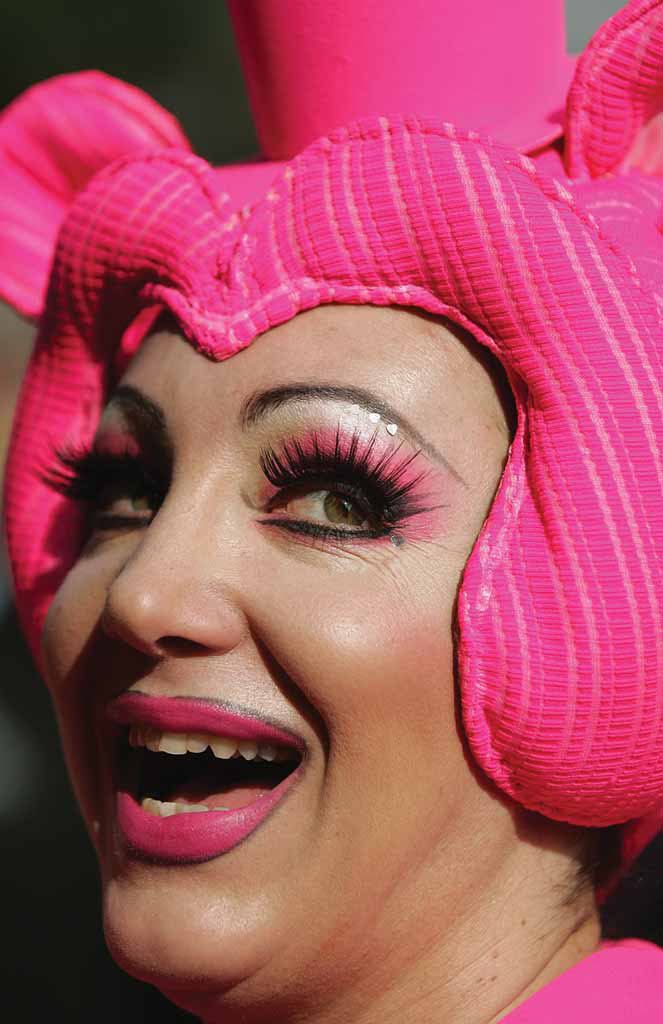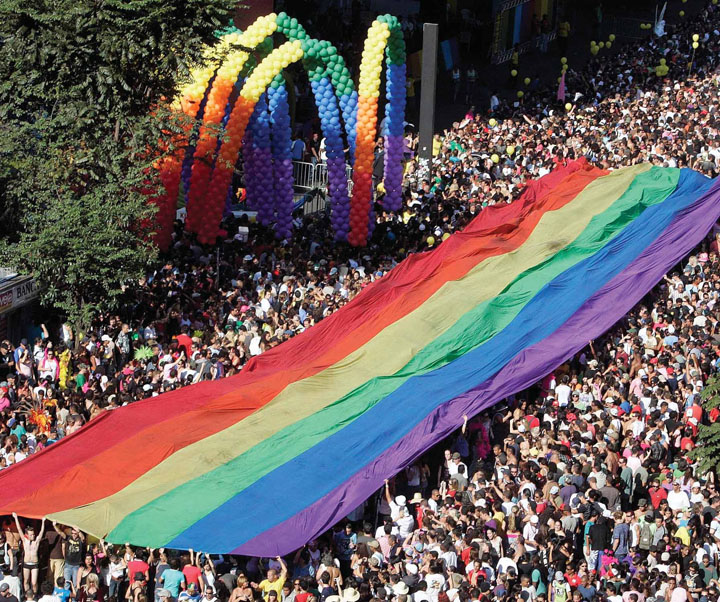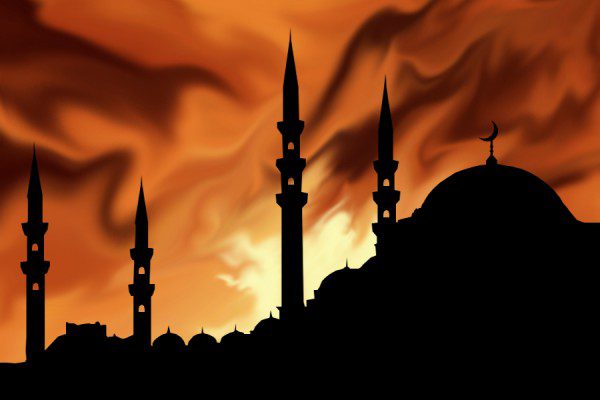Yes, Marcos is gay. Marcos is gay in San Francisco, Black in South Africa, an Asian in Europe, a Chicano in San Ysidro, an anarchist in Spain, a Palestinian in Israel, a Mayan Indian in the streets of San Cristobal, a Jew in Germany, a Gypsy in Poland, a Mohawk in Quebec, a pacifist in Bosnia, a single woman on the Metro at 10pm, a peasant without land, a gang member in the slums, an unemployed worker, an unhappy student and, of course, a Zapatista in the mountains.
Marcos is all the exploited, marginalized, oppressed minorities resisting and saying `Enough’. He is every minority who is now beginning to speak and every majority that must shut up and listen. He is every marginalized group, searching for a way to speak. Everything that makes power and the good consciences of those in power uncomfortable – this is Marcos.
In a land where being macho commands respect, Mexican government officials tried projecting the Zapatista leader as gay. Sub-commandante Marcos responded as above, calling instead for unity among the oppressed communities worldwide.
Identification of lesbian, gay, bisexual and transgender (LGBT) as the most oppressed section of society is crucial to understanding the kinds of revolutionary change we must seek in the world. As heterosexual men & women across the globe, choose to ignore their plight, the community as whole, contains to remain stranded on the periphery.
Contrary to claims by medical practitioners and sociologists alike, the problems confronting LGBT communities are not biological, but entirely political because the debates surrounding sexual orientations and/or gender identities are socially constructed and sustained.
Sex, Gender & Sexuality: Social Constructions
The essentialist notion that sex and gender can be used interchangeably is at the crux of the problem which permeates a sexist patriarchal tradition. Critical reflections would suggest, however, that not only is determination of sex the product of our socially normative behavior, the declaration of gender is even more so.
In contemporary India, we are often asked to choose our sex from among two categories, Male or Female. This dichotomous adherence to heterosexist assumption leaves out options for Transsexuals, Intersex (Hermaphrodites) or Third Sex (Hijras).
Such unquestioned acceptance of duality of sex is shaped by how we understand we are gendered. Although we are schooled into believing that biology is the factor behind social variances of males and females (XX or XY chromosomes, male and female reproductive organs, etc), the truth is we almost never check out biological characteristics in people before perceiving them as belonging to either sex. Instead, what we notice is how people are dressed, how they wear their makeup, and how they present themselves in general conduct. In other words, we determine the sex based on how the person is socially perceived.
Hence, neither sex of any person is a fixed category, nor are gender traits directly or automatically attributable to the sex. Rather, sex and gender are associated by socialization processes, that vary across cultures, societies and families.
Thus, an individual -irrespective of the sex- who confirms to such norms is socially and politically gendered to make discriminatory and often, hateful judgments even without acknowledging them as counterproductive, leading eventually to what we know as ‘gender stereotypes’. Much of the feminist scholarship dwells on stereotypes as being harmful to gender relations. But what, however is missed out in the debate between the sexes is the overtly significant tone attached to just two sexes battling out from polar opposite camps.
What LGBT communities bring to the table is a radically different way to deconstruct our patriarchal world heritage. By their very presence, they challenge the normative of sexuality being fixedly innate in individuals. LGBT communities uproot the sexuality norms in a society, bringing to an end the monotonous conversation between heterosexual people over human rights (where humans specifically refer to either straight men or straight women).
Thus, sexual orientation and gender identities, which frame the diversity of LGBT communities are deeply imbued within gender expectations. With a two-sex world relying upon gender roles socially assigned for heterosexual beings, what, then is left to be expected of the LGBT communities? Our heterosexist, conformist mainstream media provide the immediate answers.
Media Representation: Invisible Lifestylers
Icons (in our hollow times, the celebrities) are manufactured by the news media in general. Indian mainstream press, television and commercial cinema is obsessed with churning out heroes and role models at a competing proportion on a daily basis. Since multiplicity of sexual and gender identities are ignored in favor of a heterosexist position, what the audience gets to witness is a plethora of heroes and heroines using their standardized antics (gentlemanly six-packed and lady-like seductress) of attracting each other.
Every television show of repute has an “acceptable” format of visual representation of males and females. Every commercial cinema worthy of distribution carries on with a macho actor succeeding in wooing a finally submissive actress. To prove that point, most reputed films then need to make jocular references to the third sex, Hijras or the guys who can’t fight or girls who are too aggressive. Some serious filmmakers like Madhur Bhandarkar pretend to project woman-power in corporate media while ridiculing the ‘gay politics’ in the industry (Page 3), while Karan Johar pretending to project gays in good light ends up trivializing the serious concerns as lifestyle hiccups (Dostana).

Marriage and family foundations are recurring themes across news reports, television shows and cinema productions. Since “opposites attract” according to the grand narratives, there are not only two sexes, but both the sexes are considered to be binary opposites of, hence, eternally attracted to each other. A script is unfinished until the leading protagonist has found the suitable opposite. Both gender and sexuality are abundantly explored within the media, but solely from the heterosexist lens. The ideal woman never is a lesbian, the leading man never is gay, the courtship never involves bisexual themes and the stories almost never found themselves on gender identities.
Going by the media reproductions of heterosexist claims and counterclaims, it is almost as if, the larger LGBT stories have not been simply told. Most times, lesbians and gays, haplessly isolated by the family members either prefer to remain within closets, or when they come out, they are helped out by activists outside who prescribe medical solutions, since they are depicted as “confused” over their gender identities. In reality, most gays and lesbians are quite clear over their gender identities while simply preferring sexual partners of the same sex, while many transsexuals generally go through sex-change operations because they do not find themselves fitting within their biological sex.
Don’t ask, Don’t tell: Coming out of Indian LGBT
India’s patriarchal dominant system maintains itself with help of the legal arsenals. From growing up boys and girls differently to fit their ideal roles as prospective adults, to control women as subservient child-bearers and loyal wives, the mainstream male hegemonic tendencies find active support within highest courts of our land. As a result, despite conferences on gay rights, even within the premises of Bangalore-based NationalLawSchool, we have failed to weed out Section 377 of the Indian Penal Code. However, as with rape and dowry, prosecution of the victims continually go on outside the courtroom, in the spheres of family, school, and society. Thus, despite depictions of multiple gender identities and sexual orientations in ancient Indian scripts and temples, it has been a saga of unfathomable struggle on part of the Indian LGBT to reveal them in public space.
When eminent Urdu writer Ismat Chughtai published her story Lihaaf (The Quilt) in 1944, revolving a lesbian wife’s tribulations, all hell broke lose. Chughtai, hailing from the Progressive Writers Association, was a path breaker for radical feminist thoughts – the first Indian Muslim woman to earn a bachelor’s degree and possibly the smartest defender of a public obscenity charge in courtrooms. When she was brought to court for Lihaaf, she argued the story could not corrupt someone who has not experienced lesbianism. She was acquitted!
With the Section 377 firmly in place, social conservatism gaining grounds, religious preaching across faiths heralding divine duality, the complexed love stories of individual sexual orientations have more or less remained under the wraps since Chughtai’s days.
At last, the first conference of homosexuals was to be held in Hyderabad in 1981 – an event brought to the focus of mainstream media through a Letter to the Editor on Times of India by Ashok Row Kavi, who would emerge as the most consistent voice for gay concerns in later years. In 1988, Sunday magazine would come up with a sympathetic and comprehensive cover story on gay communities in India (August 6). Debonair magazine in the same year would highlight a news of two women police officers who marry each other with help of a Hindu priest pronouncing union of souls over sexes, only to find themselves fired by the department later.
In later years, internet communities flourished as visibly as the busting of gay bars in the manner reminiscent of the Stonewall crushing in New York City three decades back. Even as Gentleman magazine in August 1991 issue highlighted a gay awareness cover theme (‘Everything You Wanted to Know about Homosexuality but Were Afraid to Find Out’) and in 1993, Mid-day ran the ill-informed “I Want My Sex” cover story, the mainstream media mostly fed on sensational headlines from the police stations. In 2001, two HIV prevention NGOs, Naz Foundation International and Bharosa were raided and the workers arrested. Government-led witch hunt continued to prosecute several gay activists on pretexts of harboring the usual suspects associated with homosexuality myths: pornographic literature and blue films.
Cops went on busting “gay rackets running online” and corporate media interviewed police authorities in order to inform the gullible audience of the rationale. Authorities expertly kept quoting Section 377 and offered headlines: “Homosexuality is a crime as heinous as murder”.
When USAID employee Pushkin Chandra and his friend Vishal were murdered in August 2004, the case was much highlighted by the informed media as one leading to discovery of 100 nude photographs by people running “homosexual syndicate”, rather than as a culmination of organized hate crime.
In such backdrops, one would shudder to publicly claim sexual orientation and gender identity. And yet, Ashok Row Kavi’s Bombay Dost which launched in May 1990 continued to hold afloat the much needed hope. Running on the success of the magazine, Row Kavi would involve himself with The Humsafar Trust gaining prominence in 1995 in areas of HIV/AIDS awareness. The trust would also go on to operate India’s first voicemail service and sexuality helpline assisted by trained counselors.
Increased awareness of lesbian and gay issues however has eluded the administrators. HIV/AIDS concerns among the marginalized, LGBT community concerns, sexuality education do not feature as prospective agendas. On the contrary, owing to the general apathy of the educated bourgeois, hostilities from the macho police force, and the cultural czars reproducing sexist myths, any assembly by the sexually oppressed communities have increasingly been about solidarity rallies and protest marches.
The first such public outing of the LGBT communities and their allies was held in Kolkata on 29 June 1999 with only 15 activists participating. Of course the occasion was apt to commemorate the 30th anniversary of the Stonewall riots in New York City. But since then, between 2004 and 2008, more than 300 activists have participated in the annual ‘Walk on the Rainbow‘ event. World AIDS Day in 2003, protests against Shiv Sena’s rampage following release of Girlfriend, World Social Forum 2004’s Rainbow March have all been notable opportunities for the LGBT communities to come together for a better possible world.
Even with the odd marches and rallies, there appears to be little consensus when it comes to supporting LGBT causes and of their socio-political emancipation. Amongst academicians, there is a staunch refusal to further LGBT studies either as interdisciplinary or specialized scholarship.
Back to Marcos: Cycles of Oppression and What needs to be Done
What Kishwar exhibits is a case of profound gender-blindness. It might be true that some of us have friends among the oppressed communities, and thanks to our upper class privileges our friends also might belong to the strata more defined by economic networks that allows them not to be discriminated against. That, however does not take away the onus on us to look outside our windows to compare how we exercise our privileges against other’s oppressed states. It is imperative that we are educated in our communities, to meet and celebrate differences among peoples, to recognize our respective oppressed states and privileged positions.
As Marcos points out, we need to declare ourselves as allies of sexual minorities. And to do that, we must expand our safe spaces to include the oppressed within our realms of knowledge, interactions and acceptances.
To challenge our privileges, let us take the following two tests. The first test asks you ‘awkward’ questions, the kinds of which would appear commonplace if you were homosexual. The second test urges upon you to recognize that all of us might be oppressed in some ways, but privileged in some others in context to structural inequality in India:
| I. Heterosexuality Questionnaire (to help you to recognize what it might feel like to be asked the following questions and hear the following comments about your sexuality.) |
| 1. What do you think caused your heterosexuality? |
| 2. When and how did you first decide you were heterosexual? |
| 3. Is it possible heterosexuality is a phase you will grow out of? |
| 4. Is it possible you are heterosexual because you fear the same sex? |
| 5. If you have never slept with someone of the same sex, how do you know you wouldn’t prefer that? Is it possible you merely need a good gay experience? |
| 6. To whom have you disclosed your heterosexuality? How did they react? |
| 7. Why are heterosexuals so blatant; always making a spectacle of their heterosexuality? Why can’t they just be who they are and not flaunt their sexuality by kissing in public, wearing rings, etc? |
| 8. Most child molesters are heterosexual men. Do you consider it safe to expose children to heterosexual males? Heterosexual male teachers particularly? |
| 9. How can you have a truly satisfying relationship with someone of the opposite sex, given the obvious physical and emotional differences? |
| 10. Given the problems heterosexuals face, would you want your family members to be heterosexual? Would you consider reparative therapy? |
| (Source: Office of Diversity and Inclusion, University of Maryland) |
II. Recognize your Privileges:
| Category | Dominant | Subordinate |
| Gender | Men | Women, transgender people |
| Caste | Brahmin | All others castes |
| Class | Middle and Upper Class | Poor, working class |
| Region | North Indians | North-east, and all other regions |
| Ethnicity | Indo-Aryans | Dravidians and indigenous peoples |
| Sexual Orientation | Heterosexual | Lesbian, gay, bisexual, transgender |
| Religion | Hindu | All other religions |
| Physical Ability | Able-bodied | Persons with disabilities |
| Age | Youth | Elderly persons |
| Language | English, Hindi | All other languages |


